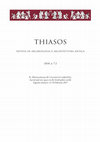Papers by kerstin höghammar
Presbeus. Studies in ancient coinage presented to Richard Ashton, 2021
This volume contains 11 articles from an international conference on ancient ports in the Greek a... more This volume contains 11 articles from an international conference on ancient ports in the Greek and Roman world from the Classical period to Late Antiquity. The Graeco-Roman civilization was, to a large extent, built on a constant flow of people, goods and ideas between various parts of the Mediterranean. This volume treats the function, character and connectivity of ports in the Greek and Roman Mediterranean. The following topics are discussed: the role of river and sea ports locally, regionally and Mediterranean-wide; the freighting on rivers; the infrastructure of large harbours; the role of the hinterland; sea-routes; connectivity and the social character of harbour cities through time.

The paper treats 204 foreigners buried on Kos in the Hellenistic period; a diachronic analysis is... more The paper treats 204 foreigners buried on Kos in the Hellenistic period; a diachronic analysis is made of their place of origin, which larger regions in the Mediterranean and the Black Sea they came from, and their sex. It also notes 17 Koans buried abroad and reported in IG XII 4, 4. The foreigners buried on Kos come from 84 different places, the majority from areas east of the island, either close by (Ionia and Karia, especially Halikarnassos) or far away (the Eastern end of the Mediterranean, especially Antiocheia (on-the-Orontes?)). Ca. two-thirds are men and ca. one third are women. The women became more numerous in the 2nd and 1st centuries. The dataset indicates a high percentage of foreigners in Kos town just as in Rhodos and Athens. This, together with a strong presence of people from three large trading cities (Antiocheia, Alexandria, and Syracuse), suggests that Kos was a significant emporion.
The Journal of Hellenic Studies, Nov 1, 1999

The moving movers. Foreigners buried on Kos in the Hellenistic period, 2021
The paper treats 204 foreigners buried on Kos in the Hellenistic period; a diachronic analysis is... more The paper treats 204 foreigners buried on Kos in the Hellenistic period; a diachronic analysis is made of their place of origin, which larger regions in the Mediterranean and the Black Sea they came from, and their sex. It also notes 17 Koans buried abroad and reported in IG XII 4, 4. The foreigners buried on Kos come from 84 different places, the majority from areas east of the island, either close by (Ionia and Karia, especially Halikarnassos) or far away (the Eastern end of the Mediterranean, especially Antiocheia (on-the-Orontes?)). Ca. two-thirds are men and ca. one third are women. The women became more numerous in the 2nd and 1st centuries. The dataset indicates a high percentage of foreigners in Kos town just as in Rhodos and Athens. This, together with a strong presence of people from three large trading cities (Antiocheia, Alexandria, and Syracuse), suggests that Kos was a significant emporion.

Kungl. Humanistiska Vetenskaps-Samfundet i Uppsala. Årsbok 2018-2019, 2019
This paper describes democracy at a local level in the city-state of Kos c.
200 BC. In the Greek ... more This paper describes democracy at a local level in the city-state of Kos c.
200 BC. In the Greek city-states, civil servants included both civic and cult
officials. I investigate a group of temple officials, priests and hieropoioi, in
the deme of Halasarna, and present my results concerning their socio-economic standing in society, i.e. that a large part of these officials belong to
what we in modern terms would call the lower middle class. I also relate
the results to the present dominating view on the political development in
the city-states during the Hellenistic period (c. 320–30 BC), viz. that democracy in reality ceased to exist as a small wealthy elite took power. My
results show that on Kos, democracy was practised on a local level in the
early second century BC.
In order to clarify what ancient Greek democracy entails, I present some
similarities and differences between ancient democracy and modern parliamentary democracy. I also list the most significant traits of ancient democracy, for instance that it is direct (all full citizens can form part of the decision-making group), exclusive (only the grown male part of the population
with both parents citizens were full citizens) and only exceptionally can a
citizen hold a post for more than one or two years running.

The Dodekatheon in Kos town was served by one of the most important priests on Kos. The holders o... more The Dodekatheon in Kos town was served by one of the most important priests on Kos. The holders of the priesthood belonged to the Koan elite. The cult lasted from the mid-4th century B.C. to at least the Early Empire (early 1st century A.D.). During spring, there was a festival with public sacrifice/s in the temenos and games for the boys of the gymnasion. It is possible that, during the same festival, there was a pompé to the sanctuary in honour of Eumenes II (in the mid-2nd century). Such a procession would have proceeded along the streets following a prescribed route to the sanctuary. Circumstantial evidence suggests that the temenos was situated either close to the harbour or in or around the agora, in the northernmost part of town, and that it consisted of an enclosure with one or several altars and (probably) a temple. The magistrate responsible for making decisions concerning proxenoi (and probably also the new citizens) used the Dodekatheon for his archive. The sanctuary was important both to foreigners visiting Kos and to Koans who were interested in peace and harmony beneficial to the well-being of the Koan polis and to the success of long-distance trade.

Opuscula. Annual of the Swedish Institutes at Athens and Rome, 6, 2013
This paper presents and discusses the dates of two Koan silver issues, drachms with young Herakle... more This paper presents and discusses the dates of two Koan silver issues, drachms with young Herakles/crab and club in incuse, and hemidrachms with Apollo/lyre. A date in the 190s BC is suggested on several grounds. Weights and diameters correspond with those of HI XII and XIII of the 3rd century, suggesting that the issues discussed here followed shortly thereafter. The other Koan silver issues of the 2nd century were minted on a lower weight-standard. The IGCH 1320 hoard contains examples of both issues, and the other Koan issues in it date to the middle and second half of the 3rd century or the 190s/c. 190. Groups of homonyms occur in issues dating to the end of 3rd/early 2nd century. A connection with Kalymnos seems likely for the hemidrachms, and this may suggest a date early in the 190s during the war with king Philip V of Macedonia.

This paper attempts to place two Koan coin issues in their proper historical context. The drachms... more This paper attempts to place two Koan coin issues in their proper historical context. The drachms and hemidrachms (head of Herakles r./crab, club), Ingvaldsen series XII and XIII, ran from c. 260(?) to c. 200. The emphasis is on the last part of the issues which I consider to have been minted in the decade 210-200. Most obverse dies and coins belong to this period, and in my view, both issues can be connected to the First Kretan War which broke out c. 205. The issue of hemidrachms can also be connected to the war against Philip V of Macedonia in 201. The pressure of the wars produced a sharp increase in output of coins and affected the quality of the dies cut. In the issue of drachms we see six coiners working together as a group at the time of the Kretan War instead of, as previously, two. There seems to have been a difference between the two issues in the rhythm of minting. For the drachms an early and a late group is clearly discernable and in the period just be-fore 210 there was probably a gap in the production between the two groups. The hemidrachms show a different pattern with (probably) no gap.
Uploads
Papers by kerstin höghammar
200 BC. In the Greek city-states, civil servants included both civic and cult
officials. I investigate a group of temple officials, priests and hieropoioi, in
the deme of Halasarna, and present my results concerning their socio-economic standing in society, i.e. that a large part of these officials belong to
what we in modern terms would call the lower middle class. I also relate
the results to the present dominating view on the political development in
the city-states during the Hellenistic period (c. 320–30 BC), viz. that democracy in reality ceased to exist as a small wealthy elite took power. My
results show that on Kos, democracy was practised on a local level in the
early second century BC.
In order to clarify what ancient Greek democracy entails, I present some
similarities and differences between ancient democracy and modern parliamentary democracy. I also list the most significant traits of ancient democracy, for instance that it is direct (all full citizens can form part of the decision-making group), exclusive (only the grown male part of the population
with both parents citizens were full citizens) and only exceptionally can a
citizen hold a post for more than one or two years running.
200 BC. In the Greek city-states, civil servants included both civic and cult
officials. I investigate a group of temple officials, priests and hieropoioi, in
the deme of Halasarna, and present my results concerning their socio-economic standing in society, i.e. that a large part of these officials belong to
what we in modern terms would call the lower middle class. I also relate
the results to the present dominating view on the political development in
the city-states during the Hellenistic period (c. 320–30 BC), viz. that democracy in reality ceased to exist as a small wealthy elite took power. My
results show that on Kos, democracy was practised on a local level in the
early second century BC.
In order to clarify what ancient Greek democracy entails, I present some
similarities and differences between ancient democracy and modern parliamentary democracy. I also list the most significant traits of ancient democracy, for instance that it is direct (all full citizens can form part of the decision-making group), exclusive (only the grown male part of the population
with both parents citizens were full citizens) and only exceptionally can a
citizen hold a post for more than one or two years running.